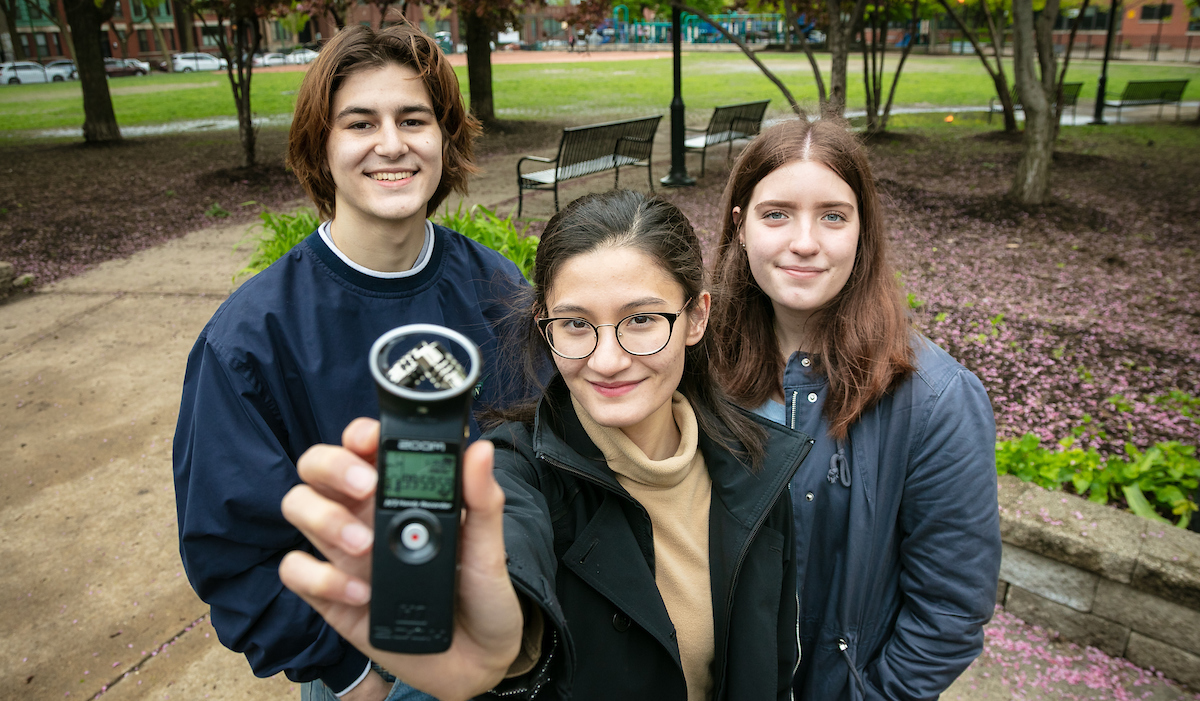 Left to right, Matthew Rosson, Ashlyn Royce and Bailey Didier, students in the College of Science and Health, are working with Liam Heneghan, professor of Environmental Science and Studies, on recording and studying soundscapes around the Chicago area. (DePaul University/Jeff Carrion)
Left to right, Matthew Rosson, Ashlyn Royce and Bailey Didier, students in the College of Science and Health, are working with Liam Heneghan, professor of Environmental Science and Studies, on recording and studying soundscapes around the Chicago area. (DePaul University/Jeff Carrion)
Living in a city, one becomes accustomed to the constant noise generated by humans and their daily activities. Think of the noise from transit alone: horns blaring, engines humming and trains running. It begs the question, does the noise in a cityscape ever stop? Can we experience silence and the sounds of nature, uninterrupted by human noise in an urban environment? Liam Heneghan, a professor in the Department of Environmental Science and Studies and his undergraduate research assistants set out during winter quarter to find out.
Heneghan and his research assistants - Bailey Didier, Matthew Rosson and Ashlyn Royce - investigated ambient noise at three sites in the city. The students are all first and second year students currently majoring in either environmental studies or environmental science in CSH.
The students recorded the sounds at Montrose Point Bird Sanctuary, North Pond by the Peggy Notebaert Nature Museum and a small cemetery in Evanston multiple times a week. Once back at DePaul with their recordings, they listened for when anthropogenic noises, or the noises of human activity, stopped and the sounds of nature prevailed.
Didier and Royce teamed up to record and study the sounds of Montrose Point, which sits on a piece of land that juts out into Lake Michigan near Montrose Harbor on the city’s north side.
“We were right on the lake. I’m grateful that we didn’t have to record during the polar vortex,” Royce says.
Both students knew human sounds would have some presence in their recordings. However, the sanctuary is a refuge for different kinds of migrating songbirds and butterflies in Chicago, so one would think nature sounds could overwhelm the anthropogenic at some point. Didier and Royce did not find this to be true, though.
“At the Montrose site, where you wouldn’t think there would be a lot of human noise, it’s constant. You could almost always hear the murmur of Lake Shore Drive from the sanctuary,” Royce says.
“One of the most constant sounds was airplanes queueing up to land at O’Hare," Didier adds. "Thirty seconds to a minute was about the longest we went without anthropogenic noises, and that’s in a sanctuary for birds."
Rosson’s studies focused on the North Pond at the intersection of Fullerton and Lake Shore Drive. Because of the close proximity to such a major intersection, Rosson’s green space was saturated with human sounds.
“The traffic noise never stopped,” Rosson says. “The North Pond site is a lot louder and a lot busier than the other ones. I think the longest period without human sounds was probably zero because of the traffic."
Heneghan notes although there are differences between the sites, the results so far are clear - few opportunities exist to get away from the sounds of human activities in a city.
“Rarely does a minute pass without the noise of cars, trains or planes intruding,” Heneghan says. “Though this might not seem very surprising, quantifying this phenomenon is important. There is some evidence suggesting human health and well-being can improve when we are not bombarded by anthropogenic noise.”
There is sometimes a notion among undergraduate students that research opportunities are preserved for older students because of their ‘experience,’ but first year student Rosson affirms that this is not the case.
“I just asked Dr. Heneghan about it after class one day when he mentioned the research opportunity and he was happy to let me join,” Rosson says. “You don’t need prior experience – the professors teach you, and you pick it up quickly.”
The next step for Heneghan and his assistants is to determine what the data means for biodiversity and restoration in Chicago’s green spaces.
“We want to look at areas in the city that have undergone ecological restoration and attempt to measure the success of the restoration by measuring the amount of anthropogenic sound against species and plant diversity,” Royce says.
Rosson and Didier will continue their field research over the summer looking at restoration sites with Heneghan along with some graduate students, while Royce will work with the Kellogg Institute looking at surveys conducted on farmers’ decisions and sustainable agriculture.